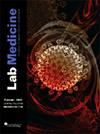电解质:地球上的盐
IF 1
4区 医学
Q4 MEDICAL LABORATORY TECHNOLOGY
引用次数: 6
摘要
作为医学实验室的科学家,在进行血浆电解质分析时需要知道什么?关于电解质分析的最佳实验室实践,你应该考虑哪些新信息?这篇评论文章将回答其中的一些问题。在人体生理学中,在细胞外液(ECF)体积和体内总水(h2o)含量的背景下,最好是指电解质,它是体液的主要成分。电解质也是最好的参考,而不是单独参考,因为它们是一个完整的生理机制的一部分,h2o和离子平衡。口渴、肾功能和激素反应有助于维持体内电解质的平衡。这些实体在代谢途径、酶激活、酸碱平衡、肌肉功能调节和神经组织收缩的一般功能中发挥作用。电解质水平的控制以h2o和pH平衡为基础,并由肾脏通过近曲小管主动转运、渗透和被动扩散等过程来实现。在细胞水平上,钠(NA)和钾(K)水平由NA -K -腺苷三磷酸酶(atp酶)泵维持。1内分泌系统通过肾素-醛固酮系统和体液中血管加压素和利钠肽的循环水平影响远曲小管。本文章由计算机程序翻译,如有差异,请以英文原文为准。
Electrolytes: The Salts of the Earth
What do you need to know as medical laboratory scientists when performing plasma electrolyte analysis? What new information should you consider regarding best laboratory practice in electrolyte analysis? This review article will answer some of these questions. Background In human physiology it is best to refer to electrolytes, the main component in bodily fluids, in the context of extracellular fluid (ECF) volume and total water (H 2 O) content in the body. Electrolytes are also best referenced collectively rather than individually because they are part of an integrated physiological mechanism of H 2 O and ionic balance. Thirst, renal function, and hormonal response help to maintain homeostasis of electrolytes. 1 These entities play a role in general functions of metabolic pathways, enzyme activation, acid-base balance, muscular-function regulation, and nervous-tissue contractions. Control of electrolyte levels is based on H 2 O and pH balance and is enacted by the renal glands through processes such as active transport in the proximal convoluted tubules, osmosis, and passive diffusion. At a cellular level, sodium (NA) and potassium (K) levels are maintained by the Na-K–adenosine triphosphatase (ATPase) pump. 1 The endocrine system influences the distal convoluted tubules via the renin-aldosterone system and the circulating levels of vasopressin and natriuretic peptides in bodily fluids.
求助全文
通过发布文献求助,成功后即可免费获取论文全文。
去求助
来源期刊

Labmedicine
医学-医学实验技术
CiteScore
2.50
自引率
0.00%
发文量
155
审稿时长
>12 weeks
期刊介绍:
Lab Medicine is a peer-reviewed biomedical journal published quarterly by the ASCP and Oxford University Press. The journal invites submission of manuscripts on topics related to clinical chemistry and microbiology, hematology, immunology, transfusion medicine, molecular diagnostics, cytology, histology, and laboratory administration and management. Original research, reviews, and case reports are considered for publication. Lab Medicine is indexed (under the title Laboratory Medicine) by the National Library of Medicine and is included in the PubMed database.
 求助内容:
求助内容: 应助结果提醒方式:
应助结果提醒方式:


